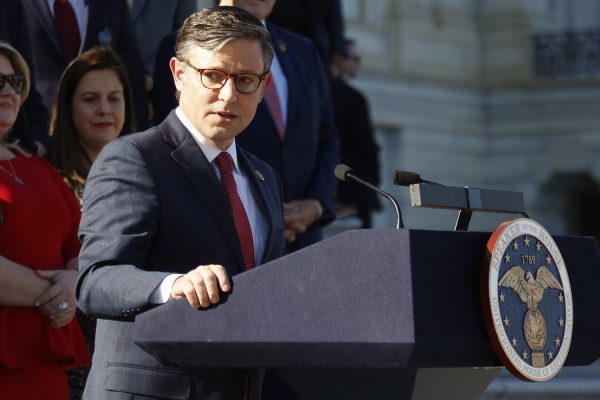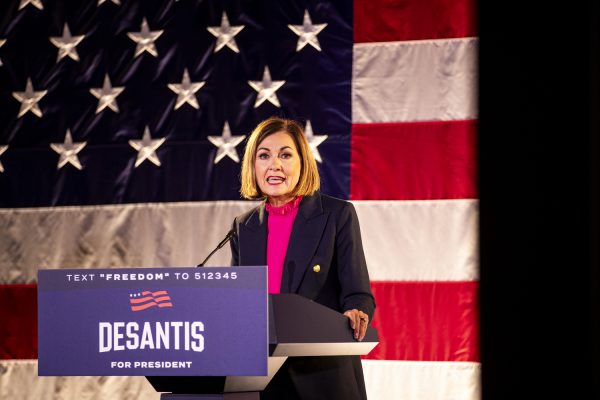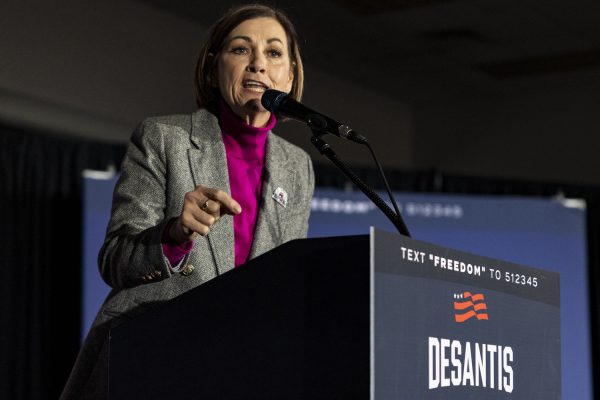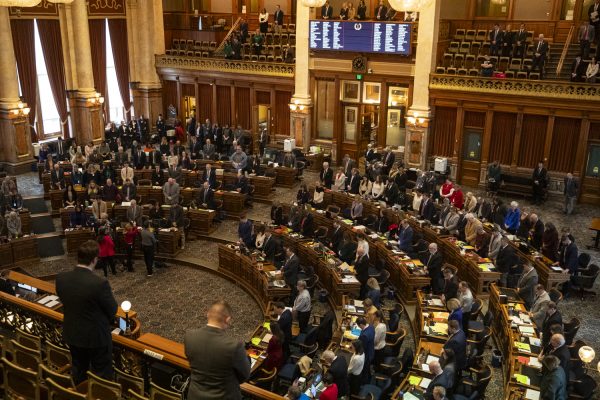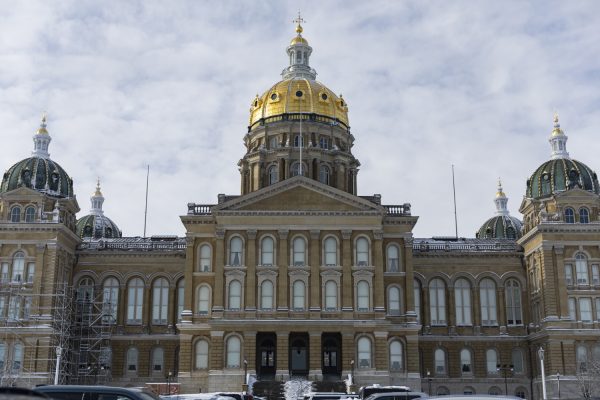Special redistricting session approaches, elected officials tout Iowa’s process
Iowa lawmakers head to the Statehouse on Tuesday for a special session to consider and approve a redistricting plan.
Members of the Iowa senate take part in the opening of the 2021 legislative session on Monday, Jan. 11, 2021 at the Iowa State Capitol in Des Moines. Legislative goals for the session include further tax cuts, expanding in-person learning, and moving towards economic recovery from the COVID-19 pandemic.
As Iowa legislators prepare to return to the state capitol on Tuesday, leaders from both parties have indicated their willingness to pass the first set of maps that have been drawn for Iowa’s national and state districts, but uncertainty still looms over the process.
Iowa’s nonpartisan congressional and legislative redistricting process exists to keep politics out of redistricting, Secretary of State Paul Pate said. The maps are drawn by the nonpartisan Iowa Legislative Services Agency, which is forbidden from using political data to draw the maps.
Redistricting is done in every U.S. state every decade following the census, and Iowa’s elected officials tout its nonpartisan process as a model for the nation.
“The politicians take hands off and allow the professional experts in mapping and districting to do it,” Pate said. “That takes the temptation away for people looking at, ‘Well, make sure we’ve got to take care of Bob or Susan’s district, or let’s not put our political party in a bad position.’ It’s much more objective.”
The Legislative Services Agency released this year’s first redistricting plan on Sept. 16. Lawmakers need to approve a set of maps by Dec. 1.
Redistricting standards set by the U.S. Constitution, the Iowa Constitution, and Iowa Code section 42.4 dictate that each of the congressional and legislative districts in Iowa have populations as close as possible to the ideal population. The average deviation from the proposed population must be lower than 1 percent in congressional and legislative districts, and none of the state legislative districts can have a population exceeding any other district by more than 5 percent. Additionally, counties must not be split into different congressional districts.
The Iowa Legislative Services Agency, a nonpartisan group that provides committee staffing, legal drafting, budgeting services to the General Assembly, cannot consider addresses of incumbents, voter registration data, previous election results, or demographic information other than the population.
RELATED: Sen. Chuck Grassley’s career by the numbers.
The ideal population set by the Legislative Services Agency for Iowa Senate districts is 63,807, and the average deviation is 201.82 persons. For the Iowa House districts, the ideal population is 31,904 and the average deviation 125.77 persons.
Based on data from the 2020 census count, the Legislative Services Agency set the ideal population for each of Iowa’s four congressional districts at 797,592. Iowa’s proposed 1st Congressional District has the highest population, with 63 more than the ideal, and the 2nd Congressional District has the lowest population, with 36 fewer people than the ideal. That average deviation from the ideal population is 31.25 persons.
According to October voter registration numbers from the Secretary of State’s office, Republicans hold a majority in Iowa’s current 4th Congressional District, while the other three districts have more registered Democrats than Republicans.
Based on the October voter registration numbers, Republicans would maintain a majority in the 4th Congressional District and have a slight majority in the 2nd Congressional District, if the first maps are approved. Democrats would have a slight majority in the 3rd district. In the first district, registered Democrats would have a 61,000 lead over registered Republicans.
The 1st Congressional District is represented by Republican Rep. Ashley Hinson.
If the first map is approved, Johnson County would move from the 2nd Congressional District, represented by Republican Rep. Mariannette Miller-Meeks, to the 1st District.
None of Iowa’s current Congressional delegation would have to move to remain in their current district, but state Rep. Christina Bohannan, D-Iowa City — who announced in August that she is challenging Miller-Meeks in 2022 — would no longer live in the 2nd District at her current address, although according to the Constitution, representatives do not have to live in the district they represent.
“I don’t think you necessarily have an unfair map, by any means, for either party necessarily, and that really, you should not be passing them out based purely on political motives,” Iowa House Speaker Rep. Pat Grassley, R-New Hartford, said in an interview on Iowa Press. “That’s not one of the criteria we’re supposed to follow. I know some people on both sides don’t like parts of it, but really you have to look at the things laid out in the code and what the expectations of the Legislature is.”
“Of course political considerations are part of the conversation, but they shouldn’t be part of the decision-making process,” House Minority Leader Rep. Jennifer Konfrst, D-Windsor Heights, said in an interview with the DI. “We’re supposed to decide this map based on its fairness, not based on whether it’s good for us politically. And so, because of that, I know that I’m planning to support the map. I was planning to support the map before it came out, because a fair map is what matters.”
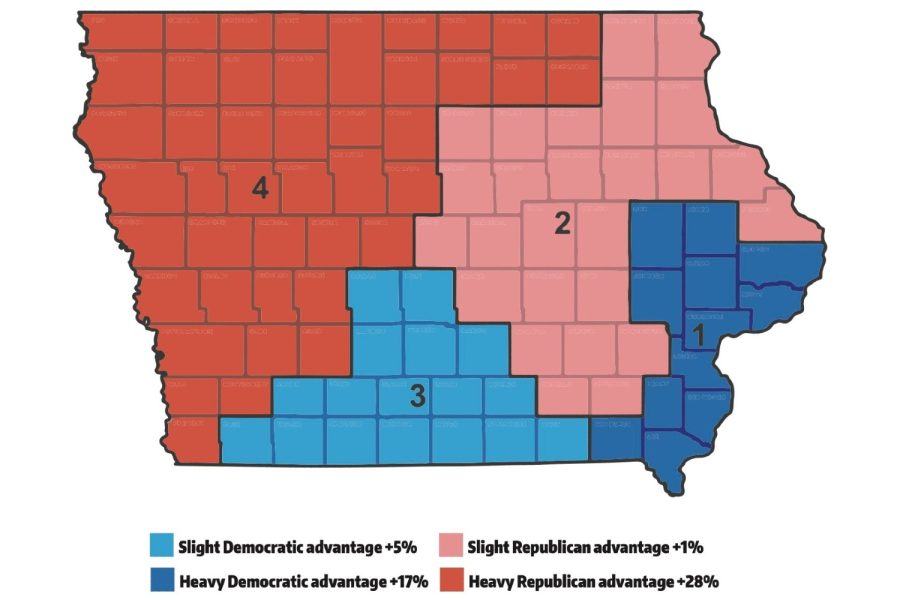
The Temporary Redistricting Advisory Commission held virtual public hearings on Sept. 20, 21, and 22, where it received mostly complementary comments on the nonpartisan process.
“The Commission acknowledges that a majority of Iowans who expressed an opinion to the Commission are in favor of Iowa’s redistricting process and the first proposed redistricting plan,” a report released from the commission on Sept. 27 said.
Legislators will have to vote yes or no on the first plan without any amendments to the maps. If lawmakers reject the first plan, the Legislative Services Agency will be required to draw a second set of maps — lawmakers are not allowed to make amendments to the second set either. If the second set is rejected, the Legislative Services Agency will draw a third, and this plan can be amended by lawmakers.
This final option hasn’t happened in the history of Iowa’s redistricting, Pate said.
“Both parties have done a pretty good job of encouraging their members, the legislators, to not jump to a yes or no kind of thing — particularly no — until they’ve had a chance to really look at it, get together as a group, and have a chance to have a dialogue,” Pate said. “Because there’s not gonna be any map that’s gonna please everybody, it just can’t happen.”
RELATED: Iowa legislature called for special redistricting session
Senate Minority Leader Zach Wahls, D-Coralville, said he is cautiously optimistic that Iowans will see fair maps without political amendments.
“I really hope that the session we go in on October 5, we approve the maps, we gavel out, keep it nice and tight. I think that the sooner we can put the redistricting process behind us, the better for everybody, Republicans and Democrats,” Wahls said. “We’re ready to just get on to 2022 and get this over with.”
He said the biggest concern for Democrats is that the Republican majority could amend the third set of maps if the first two plans are voted down.
“We strongly oppose any partisan amendment that Republicans might use as a way to try and gerrymander,” Wahls said. “We don’t think that will happen. We hope it doesn’t happen.”
Konfrst said House Democrats want to only work on the maps, not other legislative priorities, when lawmakers return to the Statehouse.
“We’ve got time in January to talk about all the other priorities,” she said. “This is a session that was designed to talk about maps.”
Grassley said on Iowa Press that the Legislature is already eight months behind in the redistricting process because of COVID-19 delays, so he doesn’t want to be bogged down by other legislation.
If the first set of maps are voted down, the Legislative Services Agency has 30 days to draw new maps. Pate said lawmakers are crunched for time to approve the maps because the pandemic delayed the release of census data.
“I suspect that the legislative leadership will probably encourage the LSA to expedite and don’t take 30 days, because that would push us pretty far down the road,” Pate said.
Editor’s note: This article has been updated to reflect that U.S. Representatives do not need to live in the district they represent.

(she/her/hers)
Natalie Dunlap is the Assistant Digital Editor at The Daily Iowan. She is the host and producer of the Above the Fold news podcast. She...




